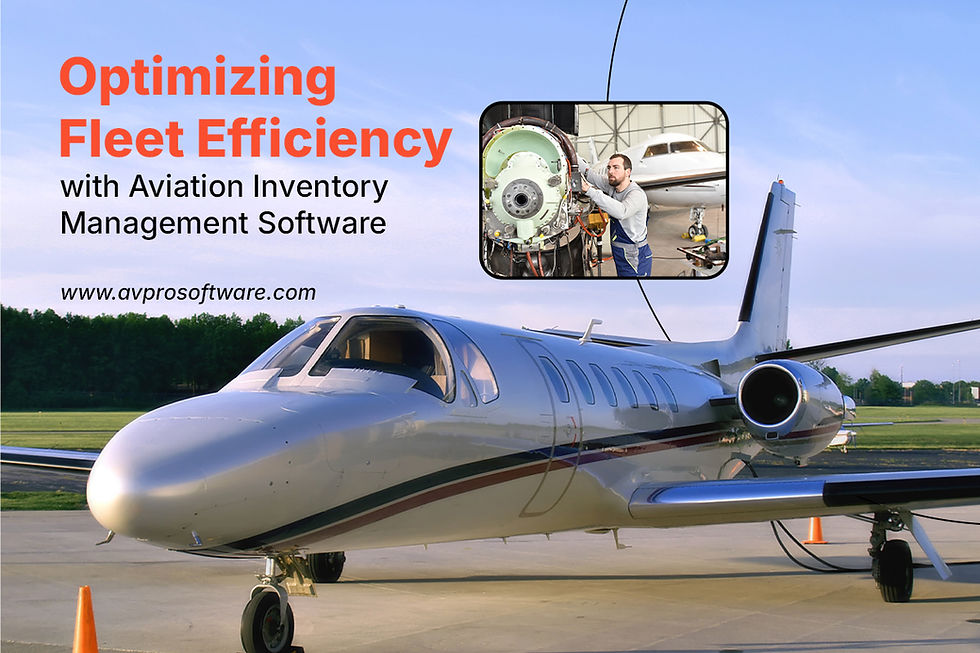Streamlining Aviation Operations with Smart Aircraft Inventory Software
- Aaron Schacht

- Sep 24
- 3 min read
In the aviation industry, precision is everything. From flight schedules to safety checks, every detail matters. Among these critical components, managing spare parts and supplies is often overlooked, yet it plays a vital role in keeping aircraft in the sky. This is where aviation inventory management software steps in, providing airlines, maintenance teams, and operators with the ability to manage parts, track usage, and prevent costly delays.
Why Aviation Inventory Management Matters
Unlike other industries, aviation operates under strict safety regulations. An unavailable part doesn’t just delay operations—it can ground an entire aircraft, disrupt schedules, and cost companies thousands of dollars per hour. Manual tracking through spreadsheets or outdated systems often leads to inefficiencies such as overstocking, misplaced items, or long waiting times for critical parts.
Aircraft inventory software solves these challenges by creating a structured, real-time system to track every nut, bolt, and engine component. It ensures the right parts are always available when needed, improving safety, reliability, and cost-efficiency.
Key Benefits of Aviation Inventory Management Software
1. Real-Time Visibility:- Modern inventory systems provide instant updates on stock levels across multiple warehouses or locations. This transparency helps operators avoid shortages and ensures compliance with strict aviation regulations.
2. Cost Control:- Overstocking can be as problematic as understocking. Intelligent software balances demand forecasting with real-time usage, reducing unnecessary spending while ensuring essential parts are always available.
3. Maintenance Efficiency:- Timely maintenance is crucial in aviation. Inventory software supports Maintenance, Repair, and Overhaul (MRO) processes by linking part availability with scheduled checks, preventing downtime and last-minute delays.
4. Regulatory Compliance:- Aviation authorities require detailed tracking of parts, including their origins, installation dates, and usage history. Inventory software automates record-keeping, reducing human error and ensuring compliance with global safety standards.
5.Data-Driven Decision Making:- With advanced reporting tools, operators gain valuable insights into inventory trends, supplier performance, and cost analysis. This data helps in making informed purchasing and stocking decisions.
Features to Look For in Aircraft Inventory Software
Not all solutions are created equal. When evaluating systems, these features are especially important:
Barcode and RFID Scanning for quick and error-free part tracking.
Automated Alerts for low stock levels or expiring parts.
Multi-Location Management to oversee warehouses in different regions.
Integration with Maintenance Systems to align parts availability with repair schedules.
Cloud Access for remote monitoring and mobile updates.
The Role of Technology in Aviation’s Future
As the aviation industry embraces digital transformation, software systems are becoming smarter and more predictive. Artificial intelligence and machine learning are increasingly used to forecast part demand, optimize supply chains, and reduce costs. In the near future, aircraft inventory software won’t just react to shortages—it will predict them before they happen.
For airlines and maintenance providers, investing in robust aviation inventory management is no longer a luxury—it’s a necessity. Whether it’s ensuring regulatory compliance, improving operational efficiency, or reducing downtime, the right system can transform inventory from a challenge into a strategic advantage.
FAQ
Q1: What is aviation inventory management software?
Aviation inventory management software is a digital system designed to track, manage, and optimize aircraft spare parts and supplies. It helps ensure the right parts are available at the right time, reducing downtime and costs.
Q2: How does aircraft inventory software improve safety?
By keeping accurate records of part usage, expiry, and maintenance schedules, the software ensures that only airworthy and compliant parts are used, directly contributing to flight safety.
Q3: Can aviation inventory software reduce operational costs?
Yes, it prevents overstocking, minimizes part shortages, and streamlines supplier management, which lowers unnecessary expenses and improves cost efficiency.
Q4: What industries use aviation inventory management systems?
Airlines, aircraft maintenance organizations (MROs), private aviation companies, and even government aviation bodies rely on these systems to manage their parts and equipment efficiently.
Q5: Does aircraft inventory software support regulatory compliance?
Absolutely. It automates record-keeping, maintains detailed audit trails, and ensures compliance with aviation safety regulations worldwide.






Comments